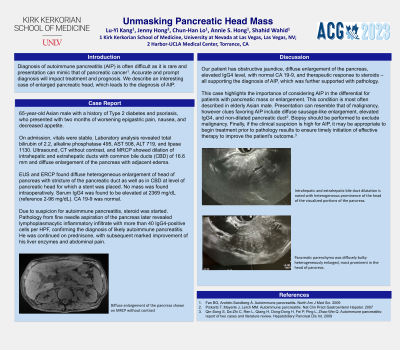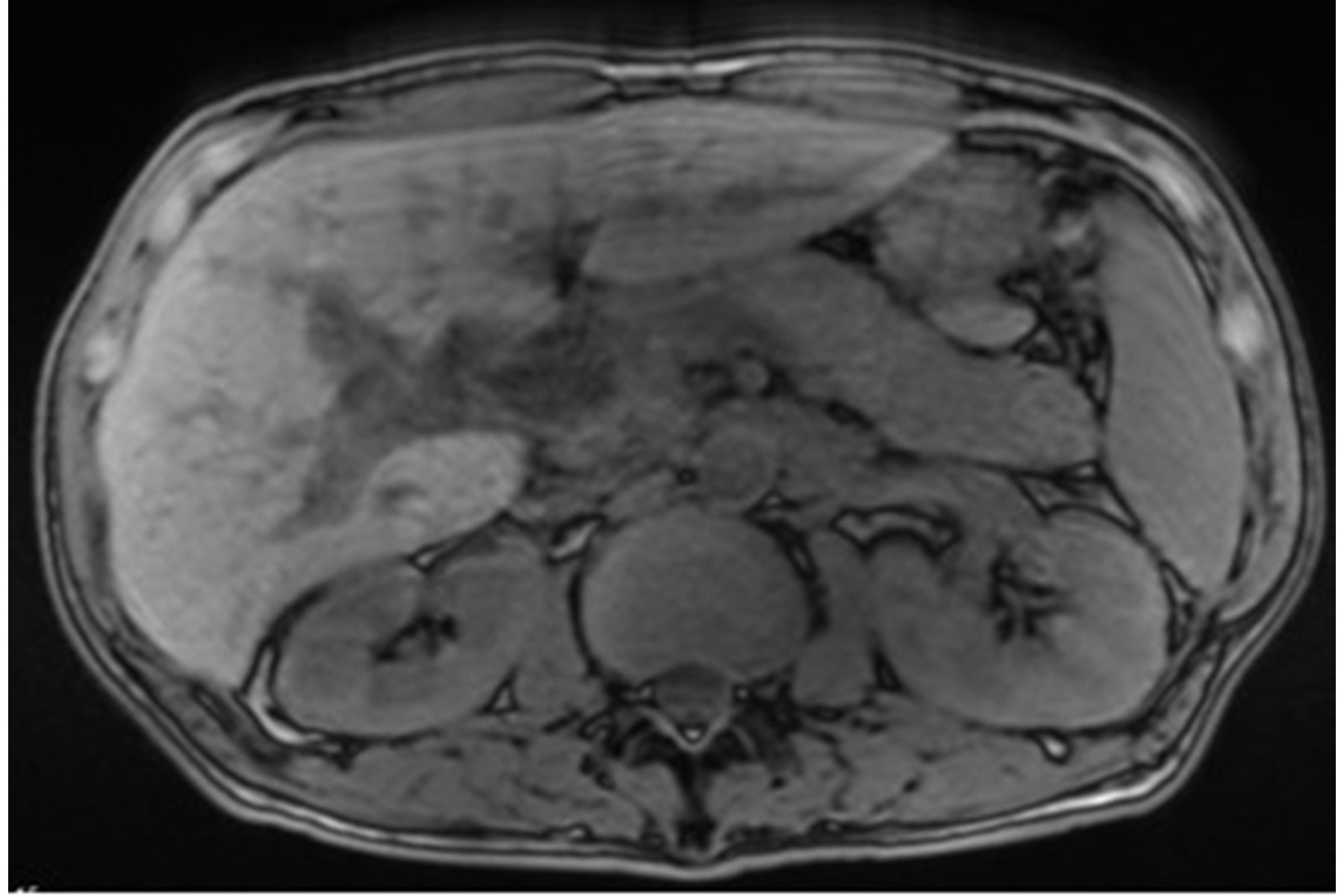Tuesday Poster Session
Category: Biliary/Pancreas
P2957 - Unmasking the Head of the Pancreas
Tuesday, October 24, 2023
10:30 AM - 4:00 PM PT
Location: Exhibit Hall

Has Audio
- LK
Lu-Yi Kang, DO
Kirk Kerkorian School of Medicine at UNLV
Las Vegas, Nevada
Presenting Author(s)
Lu-Yi Kang, DO1, Jenny Hong, MD2, Chun-Han Lo, MD, MPH1, Annie S.. Hong, MD3, Shahid Wahid, MD1
1Kirk Kerkorian School of Medicine at UNLV, Las Vegas, NV; 2Harbor-UCLA Medical Center, Torrance, CA; 3Kirk Kerkorian School of Medicine, Las Vegas, NV
Introduction: Diagnosis of autoimmune pancreatitis (AIP) is often difficult as it is rare and presentation can mimic that of pancreatic cancer. Accurate and prompt diagnosis will impact treatment and prognosis. We describe an interesting case of enlarged pancreatic head, which leads to the diagnosis of AIP.
Case Description/Methods: A 65-year-old Asian male with a history of Type 2 diabetes and psoriasis presented with two months of worsening epigastric pain, nausea, and decreased appetite.
On admission, vitals were stable. Laboratory analysis revealed total bilirubin of 2.2, alkaline phosphatase 495, AST 508, ALT 719, and lipase 1130. Ultrasound, CT without contrast, and MRCP showed dilation of intrahepatic and extrahepatic ducts with common bile ducts (CBD) of 16.6 mm and diffuse enlargement of the pancreas with adjacent edema. EUS and ERCP found diffuse heterogeneous enlargement of head of pancreas with stricture of the pancreatic duct as well as in CBD at level of pancreatic head for which a stent was placed. No mass was found intraoperatively. Serum IgG4 was found to be elevated at 2369 mg/dL (reference 2-96 mg/dL). CA 19-9 was normal. Due to suspicion for autoimmune pancreatitis, steroid was started. Pathology from fine needle aspiration of the pancreas later revealed lymphoplasmacytic inflammatory infiltrate with more than 40 IgG4-positive cells per HPF, confirming the diagnosis of likely autoimmune pancreatitis. He was continued on prednisone, with subsequent marked improvement of his liver enzymes and abdominal pain.
Discussion: Our patient has obstructive jaundice, diffuse enlargement of the pancreas, elevated IgG4 level, with normal CA 19-9, and therapeutic response to steroids – all supporting the diagnosis of AIP, which was further supported with pathology.
This case highlights the importance of considering AIP in the differential for patients with pancreatic mass or enlargement. This condition is most often described in elderly Asian male. Presentation can resemble that of malignancy, however clues favoring AIP include diffuse sausage-like enlargement, elevated IgG4, and non-dilated pancreatic duct. Biopsy should be performed to exclude malignancy. Finally, if the clinical suspicion is high for AIP, it may be appropriate to begin treatment prior to pathology results to ensure timely initiation of effective therapy to improve the patient's outcome.

Disclosures:
Lu-Yi Kang, DO1, Jenny Hong, MD2, Chun-Han Lo, MD, MPH1, Annie S.. Hong, MD3, Shahid Wahid, MD1. P2957 - Unmasking the Head of the Pancreas, ACG 2023 Annual Scientific Meeting Abstracts. Vancouver, BC, Canada: American College of Gastroenterology.
1Kirk Kerkorian School of Medicine at UNLV, Las Vegas, NV; 2Harbor-UCLA Medical Center, Torrance, CA; 3Kirk Kerkorian School of Medicine, Las Vegas, NV
Introduction: Diagnosis of autoimmune pancreatitis (AIP) is often difficult as it is rare and presentation can mimic that of pancreatic cancer. Accurate and prompt diagnosis will impact treatment and prognosis. We describe an interesting case of enlarged pancreatic head, which leads to the diagnosis of AIP.
Case Description/Methods: A 65-year-old Asian male with a history of Type 2 diabetes and psoriasis presented with two months of worsening epigastric pain, nausea, and decreased appetite.
On admission, vitals were stable. Laboratory analysis revealed total bilirubin of 2.2, alkaline phosphatase 495, AST 508, ALT 719, and lipase 1130. Ultrasound, CT without contrast, and MRCP showed dilation of intrahepatic and extrahepatic ducts with common bile ducts (CBD) of 16.6 mm and diffuse enlargement of the pancreas with adjacent edema. EUS and ERCP found diffuse heterogeneous enlargement of head of pancreas with stricture of the pancreatic duct as well as in CBD at level of pancreatic head for which a stent was placed. No mass was found intraoperatively. Serum IgG4 was found to be elevated at 2369 mg/dL (reference 2-96 mg/dL). CA 19-9 was normal. Due to suspicion for autoimmune pancreatitis, steroid was started. Pathology from fine needle aspiration of the pancreas later revealed lymphoplasmacytic inflammatory infiltrate with more than 40 IgG4-positive cells per HPF, confirming the diagnosis of likely autoimmune pancreatitis. He was continued on prednisone, with subsequent marked improvement of his liver enzymes and abdominal pain.
Discussion: Our patient has obstructive jaundice, diffuse enlargement of the pancreas, elevated IgG4 level, with normal CA 19-9, and therapeutic response to steroids – all supporting the diagnosis of AIP, which was further supported with pathology.
This case highlights the importance of considering AIP in the differential for patients with pancreatic mass or enlargement. This condition is most often described in elderly Asian male. Presentation can resemble that of malignancy, however clues favoring AIP include diffuse sausage-like enlargement, elevated IgG4, and non-dilated pancreatic duct. Biopsy should be performed to exclude malignancy. Finally, if the clinical suspicion is high for AIP, it may be appropriate to begin treatment prior to pathology results to ensure timely initiation of effective therapy to improve the patient's outcome.

Figure: Diffuse enlargement of the pancreas shown on MRCP without contrast
Disclosures:
Lu-Yi Kang indicated no relevant financial relationships.
Jenny Hong indicated no relevant financial relationships.
Chun-Han Lo indicated no relevant financial relationships.
Annie Hong indicated no relevant financial relationships.
Shahid Wahid indicated no relevant financial relationships.
Lu-Yi Kang, DO1, Jenny Hong, MD2, Chun-Han Lo, MD, MPH1, Annie S.. Hong, MD3, Shahid Wahid, MD1. P2957 - Unmasking the Head of the Pancreas, ACG 2023 Annual Scientific Meeting Abstracts. Vancouver, BC, Canada: American College of Gastroenterology.
